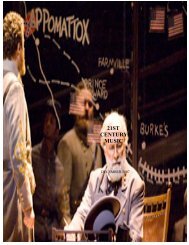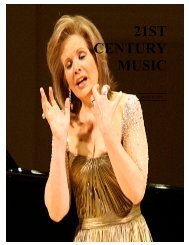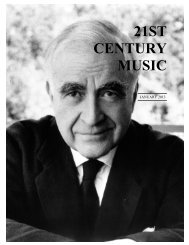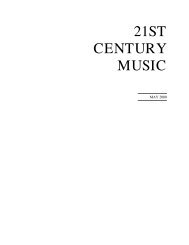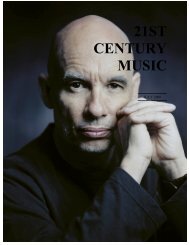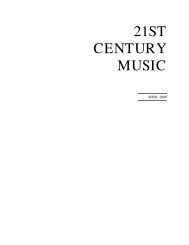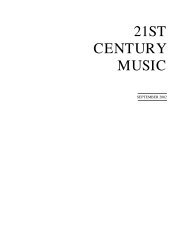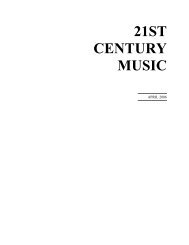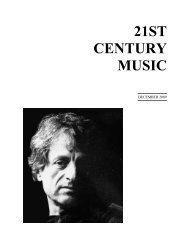You also want an ePaper? Increase the reach of your titles
YUMPU automatically turns print PDFs into web optimized ePapers that Google loves.
Bang on an Ear:<br />
An Interview with David Lang<br />
MARK ALBURGER<br />
Post-minimalist composer David Lang (b. Los Angeles) is one<br />
of the founders of the Bang on a Can Marathon and the Bang<br />
on a Can All-Stars. His Modern Painters was premiered at<br />
Santa Fe Opera in 1995. He has received commissions from<br />
the Boston Symphony, Cleveland Orchestra, St. Paul Chamber<br />
Orchestra, San Francisco Symphony, City of Birmingham<br />
Symphony Orchestra, and the American Composers<br />
Orchestra.<br />
I met with David Lang, directly after having interviewed<br />
Christian Wolfe and hours before an interview with Jacob ter<br />
Veldhuis (a marathon day which will not likely be surpassed<br />
by this writer), on March 17 in San Francisco, the day after the<br />
performance of six of his memory pieces by pianist Aki<br />
Takahashi at the sixth Other Minds Festival.<br />
ALBURGER: Unlike some of the other Other Minds<br />
participants, you can perhaps relax now.<br />
LANG: Well, yes. But Paul Dresher's doing a piece in the<br />
Opus415 Marathon this Sunday [March 19]. It's called<br />
Follow. It's a nice piece -- not very long. It's kicky.<br />
ALBURGER: The memory pieces that we heard were<br />
wonderful, but also not very long. There are two more that<br />
weren't played.<br />
LANG: One is called "wiggle," which is in memory of Frank<br />
Wigglesworth. He was a great American composer, very<br />
funny and human person, a real wonderful spirit in the New<br />
York music scene, instrumental in all sorts of generous<br />
projects. He was on the Virgil Thomson board, on the CRI<br />
board; he was involved in all sorts of "money give-aways."<br />
He was a really good guy who lived around the corner from<br />
me in the West Village. I used to see him all the time. And<br />
the last piece is called "beach," in memory of David Huntley.<br />
He was the promotion person for Boosey & Hawkes for many<br />
years. He was the same person to whom John Adams<br />
dedicated his Violin Concerto. He was an unbelievably sweet<br />
and knowledgeable person -- very smart, very interested in all<br />
sorts of music. He would call me and tell me about music that<br />
he thought we should program at Bang on a Can that had<br />
nothing to do with Boosey & Hawkes. He would hear<br />
something that he liked and he'd say, "There's this piece, it's<br />
published by Universal! And you should get it!" He was a<br />
tremendously interesting person who had dedicated his life to<br />
new music. He was really one of the old-guard new-music<br />
people who knew everything.<br />
ALBURGER: How is "cage" notated As a series of<br />
tremolos<br />
LANG: It's just tremolos, yes.<br />
ALBURGER: And it's notated staff to staff<br />
LANG: Some are normal, some are 8va, some are 15 basso.<br />
ALBURGER: But there are always just two notes<br />
LANG: It's just two notes, which alternate in every measure.<br />
ALBURGER: And change in every subsequent measure.<br />
LANG: Yes. It's basically just a bunch of scales. The next<br />
note of the scale up goes to the right-hand side, the next note<br />
of the scale down goes to the left-hand side, until it reaches a<br />
certain barrier. The piece is a kind of a mathematical rule, in<br />
reference to where the barriers are. When the top note hits the<br />
upper barrier, it just reflects down an octave until it reaches<br />
the left-hand barrier, and then it reflects back up. The piece is<br />
just a series of demonstrations as to how those two notes<br />
change. It's the same scale. How those two notes change<br />
depends on the barriers. It's really how all the set of piano<br />
pieces work. There are seven mathematical frameworks.<br />
ALBURGER: I had a sense of that, particularly in the<br />
arpeggio canon piece "spartan arcs," which begins in the right<br />
hand and continues in the left. The right hand started alone,<br />
and when the left hand finished alone, I said, "Yes!"<br />
LANG: It's actually two canons. A double canon where the<br />
accidentals get changed in certain weird ways. Every one has<br />
a weird problem. This is one of my personal favorites. It's a<br />
bunch of six-note arpeggios --<br />
ALBURGER: -- descending --<br />
LANG: -- where gradually the next arpeggio starts before the<br />
first one finishes. The net result sounds like fairly complex<br />
chords, but they're really the first three notes of the new chord<br />
superimposed over the last three notes of the old one that<br />
hasn't finished yet.<br />
ALBURGER: And rhythmically it's complex, with<br />
asymmetrical rhythms.<br />
LANG: Yes, there are asymmetrical rhythms.<br />
ALBURGER: Time signature changes<br />
LANG: Yes, time signature changes in every measure<br />
ALBURGER: 6/8 becomes 5/8, and so on.<br />
LANG: 6/16, 5/16, 4/16, 3/16, then back up to 6/16 in a very<br />
complicated process, that guarantees all sorts of asymmetries.



